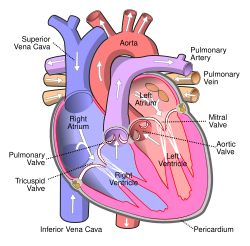
Back أذين Arabic قولاقجیق AZB Перадсэрдзе Byelorussian Srčana pretkomora BS Aurícula (cor) Catalan گوێچکەڵە CKB Srdeční síň Czech Atrium (hjertet) Danish Herz#Räume und Gefäße German Καρδιακός κόλπος Greek
| Atrium | |
|---|---|
 Front view of heart showing the atria | |
| Details | |
| Part of | Heart |
| System | Circulatory system |
| Identifiers | |
| Latin | atrium |
| MeSH | D006325 |
| TA98 | A12.1.00.017 |
| TA2 | 4022, 4054 |
| FMA | 7099 85574, 7099 |
| Anatomical terminology | |
The atrium (Latin: ātrium, lit. 'entry hall'; pl.: atria) is one of the two upper chambers in the heart that receives blood from the circulatory system. The blood in the atria is pumped into the heart ventricles through the atrioventricular mitral and tricuspid heart valves.
There are two atria in the human heart – the left atrium receives blood from the pulmonary circulation, and the right atrium receives blood from the venae cavae of the systemic circulation. During the cardiac cycle, the atria receive blood while relaxed in diastole, then contract in systole to move blood to the ventricles. Each atrium is roughly cube-shaped except for an ear-shaped projection called an atrial appendage, previously known as an auricle. All animals with a closed circulatory system have at least one atrium.
The atrium was formerly called the 'auricle'.[1] That term is still used to describe this chamber in some other animals, such as the Mollusca. Auricles in this modern terminology are distinguished by having thicker muscular walls.
- ^ Cournand, A (1947). "Recording of blood pressure from the left auricle and the pulmonary veins in human subjects with interauricular septal defect". American Journal of Physiology. Legacy Content. 150 (2). American Journal of Physiology: 267–271. doi:10.1152/ajplegacy.1947.150.2.267. PMID 20258383. Retrieved 20 March 2022.